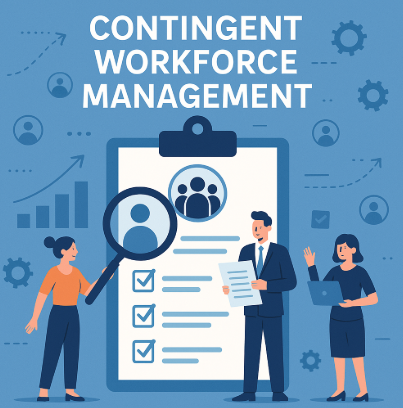The Future of Work: Why Contingent Workforce Management Matters More

Work doesn’t look the same anymore.
Gone are the days when every team was built only with full-time, in-house employees. Today’s companies are blending full-time talent with an ever-growing mix of freelancers, contractors, temporary staff, and agency workers. This is what we now call the “contingent workforce”—and it’s no longer just a side strategy. For many businesses, it’s a core part of how work gets done.
But managing a workforce that doesn’t sit at your office desks or clock in on your HR platform? That’s a whole different challenge. If you’re relying on flexible talent—or planning to—this is where a solid contingent workforce management guide becomes essential.
In this article, we’ll explore what the contingent workforce actually looks like, why it’s booming, what challenges come with it, and how to manage it successfully for long-term business growth.
What Is a Contingent Workforce?
The contingent workforce includes workers hired on a non-permanent basis. This could be:
-
Freelancers offering their skills on a per-project basis
-
Independent contractors managing their own business
-
Consultants brought in for their subject matter expertise
-
Temp workers filling gaps in staffing
-
Gig workers doing short-term assignments through platforms
They aren’t on your payroll in the traditional sense, and they may not receive the same benefits or long-term commitments as full-time employees. But they often deliver the same—if not better—levels of impact.
Why the Contingent Workforce Is Growing Fast
Several major factors are behind the shift to contingent talent:
1. Business Agility Is a Priority
Today’s economy is unpredictable. Companies need to scale teams up or down quickly. Contingent workers offer that flexibility—especially during project surges or market shifts.
2. Specialized Talent Is Easier to Access
Need a niche expert in blockchain security or a designer fluent in AR/VR? Hiring full-time may be too expensive or unnecessary. Contingent hiring gives you access to experts without the overhead.
3. Remote Work Has Gone Mainstream
With cloud tools, companies now easily collaborate with talent across time zones. The rise of remote work has removed geographic barriers for hiring.
4. Workers Prefer Flexibility
Many skilled professionals now choose to be independent. They want flexibility, autonomy, and a chance to work on diverse projects.
Key Benefits of a Contingent Workforce
Businesses that manage contingent workers well often gain serious advantages:
-
Reduced labor costs without cutting quality
-
Faster project completion through specialized hires
-
Improved innovation from fresh, outside perspectives
-
Minimal onboarding time, especially when compared to full-time hires
-
Scalability, allowing your team to grow or shrink quickly
That said, these benefits only come when you manage your workforce strategically.
The Challenges of Contingent Workforce Management
While contingent workers offer plenty of advantages, poor management can cause problems. Common challenges include:
1. Visibility Gaps
Without a system in place, managers may not even know how many contractors are working at a given time, what they’re doing, or how much they’re costing the company.
2. Legal and Compliance Issues
Misclassifying employees as independent contractors can lead to fines, lawsuits, and tax issues. Every country and region has different rules, and staying compliant is complex.
3. Security and Data Risks
When you bring in outsiders, there’s a chance they’ll access sensitive data. If protocols aren’t set, this can lead to major security breaches.
4. Performance Oversight
How do you track progress when workers aren’t on your internal systems or team dashboards? Lack of performance visibility leads to quality issues and delays.
How to Manage Contingent Workers Effectively
To truly benefit from flexible staffing, companies must rethink how they organize and manage this type of talent. Here’s how:
1. Start with a Clear Strategy
Don’t just hire contractors as a quick fix. Create a long-term workforce plan that includes full-time and contingent roles. Define when and why you use each type.
2. Use a Centralized Management Platform
Many companies now use a Vendor Management System (VMS) or other contingent workforce management software to track contracts, invoices, hours, and performance in one place.
3. Standardize Your Onboarding
Even short-term workers need access to the right tools, information, and contacts. A fast, easy onboarding process helps them deliver value faster.
4. Build Relationships, Not Just Transactions
It’s easy to treat freelancers as short-term resources—but building positive working relationships leads to better output, loyalty, and availability for future projects.
5. Follow Legal Best Practices
Avoid misclassification by using clear contracts, properly categorizing workers, and reviewing local labor laws. A reliable contingent workforce management guide can help you stay compliant.
Future Trends: What’s Next for the Contingent Workforce?
As the workplace evolves, expect to see even more development in this area:
-
Blended teams with full-time and freelance talent working side by side
-
AI-driven staffing platforms that match companies to specialized talent in seconds
-
Greater use of talent marketplaces, allowing companies to tap into a global freelance pool
-
Increased pressure for regulation, especially regarding worker rights, benefits, and classification
Businesses that start building strong contingent workforce strategies now will be better prepared for the future of work.
Final Thoughts
The modern workforce isn’t limited to 9-to-5 employees anymore. Companies that want to stay competitive need to embrace the shift to flexible talent. But that doesn’t mean hiring freelancers randomly and hoping for the best.
It means building a real system—one that helps you find, manage, and grow with skilled contingent workers while staying compliant and efficient. That’s where a strong contingent workforce management guide makes a difference.
Whether you’re just starting with freelancers or managing dozens of contractors across departments, now is the time to build a smarter strategy. With the right tools and mindset, you can turn workforce flexibility into a major competitive advantage.











